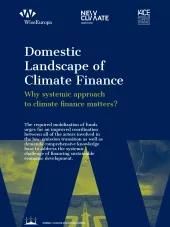This paper discusses ways to identify investments that can be accounted as low-carbon activities. The focus is on the EU Taxonomy, as in the near future it will have to be assessed to what extent this emerging tool can be useful for implementation of the climate finance landscape methodology. Subsequently, we present the added value of linking countries’ climate strategies with investment landscapes. This study offers further recommendations regarding the solutions that help to reduce the gap between current financial structures and the objectives of the national low-emission transition.
Conclusions:
Sustainable finance taxonomy and national climate strategies can often work to complement each other by bringing national contexts to provisions outlined in a classification system. Such a synergy offers useful input to the climate finance and investment tracking studies and creates an important basis for further discussions on the investment gap associated with the low-carbon transition.
Creation and implementation of the framework for climate investment and finance tracking and forecasting at the national level can substantially aid the process of mobilization of the needed climate finance and ensure that the redirection of financial flows is being governed in a strategically most effective and efficient manner. Improving policy to mobilize additional climate investment and supporting financial flows will require looking at three main areas – 1) analysis of the characteristics of the climate finance at the national level, 2) assessment of an investment gap, 3) linking countries’ climate strategies with the investment landscapes. In this paper, we have focused on two selected processes that are fundamental for such framework i.e. identification of which investments can be classified as sustainable and the analysis of the national climate strategies in the context of climate finance landscapes.
Although the uptake of these processes poses challenges, their early implementation could ensure the reduction of the gap between the current scale of climate finance flows and the scale needed to reach the objectives of the national low-emission transition. They will not only provide investors with transparent information regarding which investment decisions can help to avoid the carbon lock-in but also will enhance the monitoring of financial flows and transfer of best practices.




